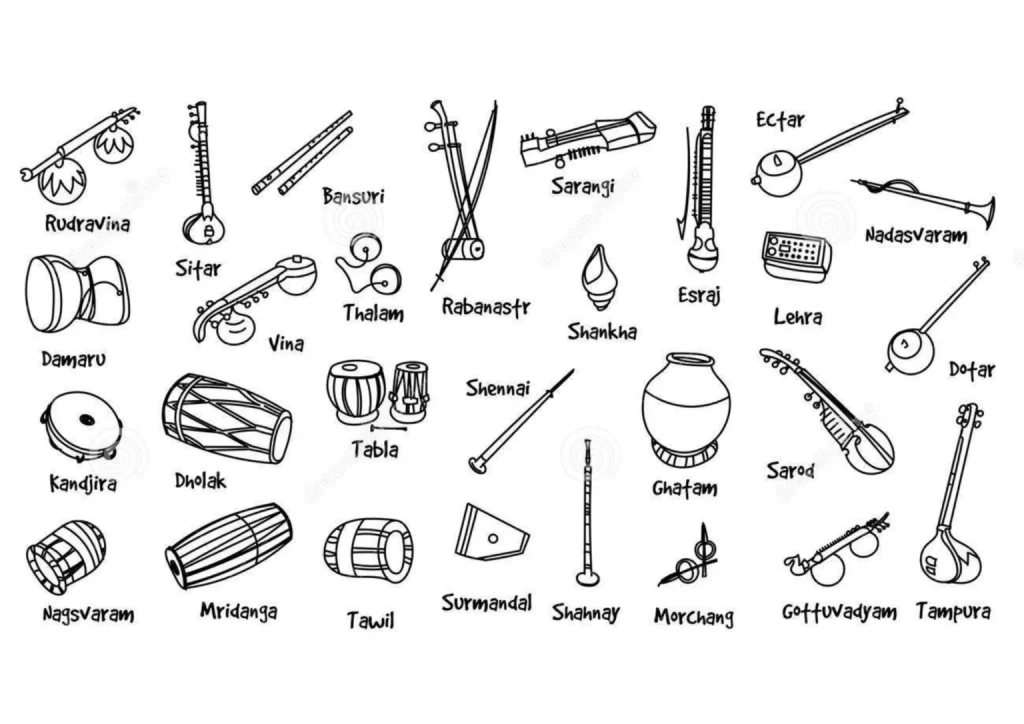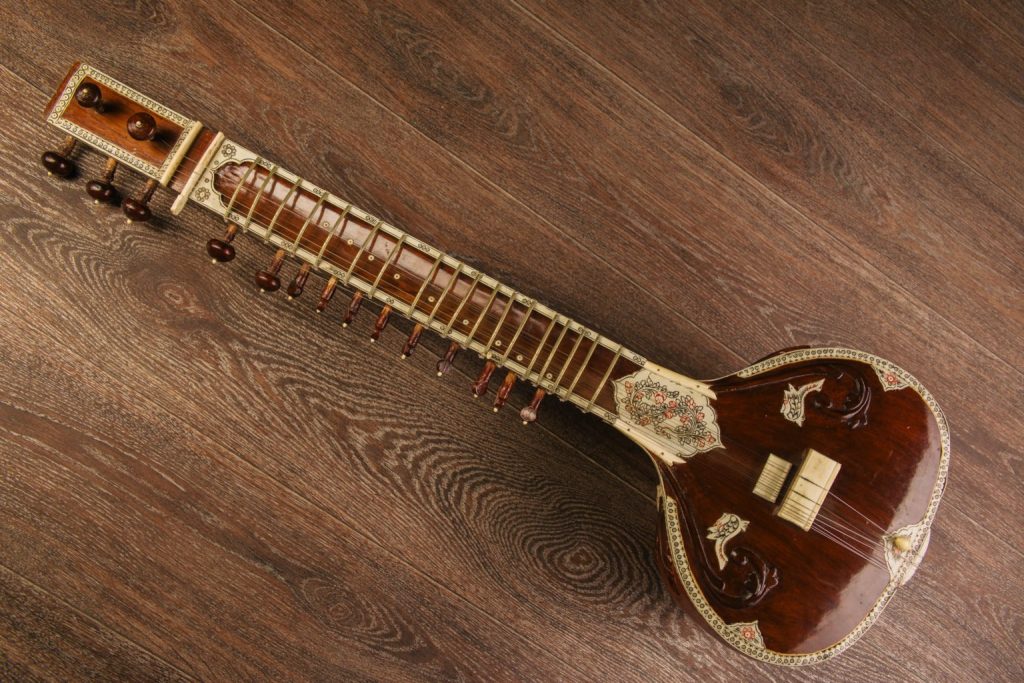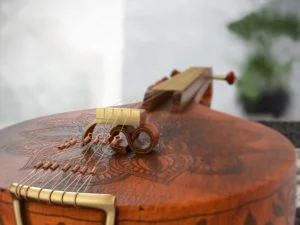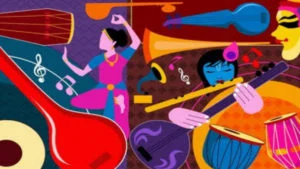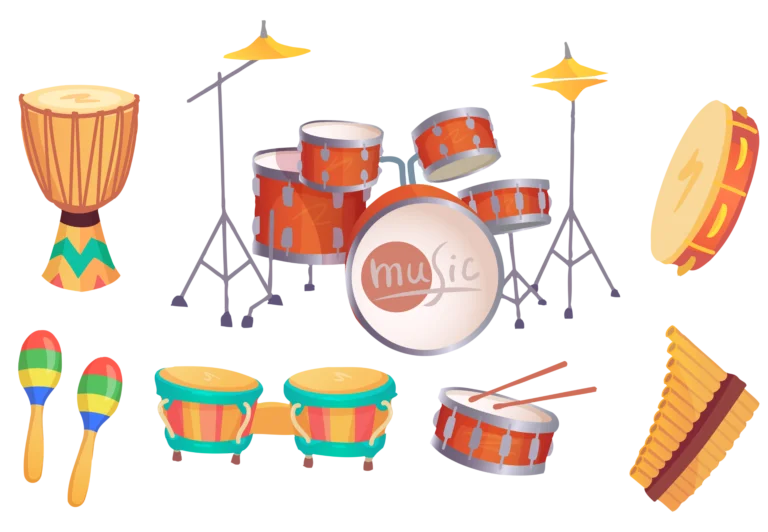Before knowing about Indian Classical Music Instruments, let’s get into the history of Indian music. In our other lesson on Indian Classical Music, we learnt that-
Indian classical music is the form of music which have originated from the Indian subcontinent.
It is basically divided into two forms of music that is the one from North India known as the Hindustani and the one that belongs to South India is called the Carnatic music.Source: Indian Classical Music for Beginners
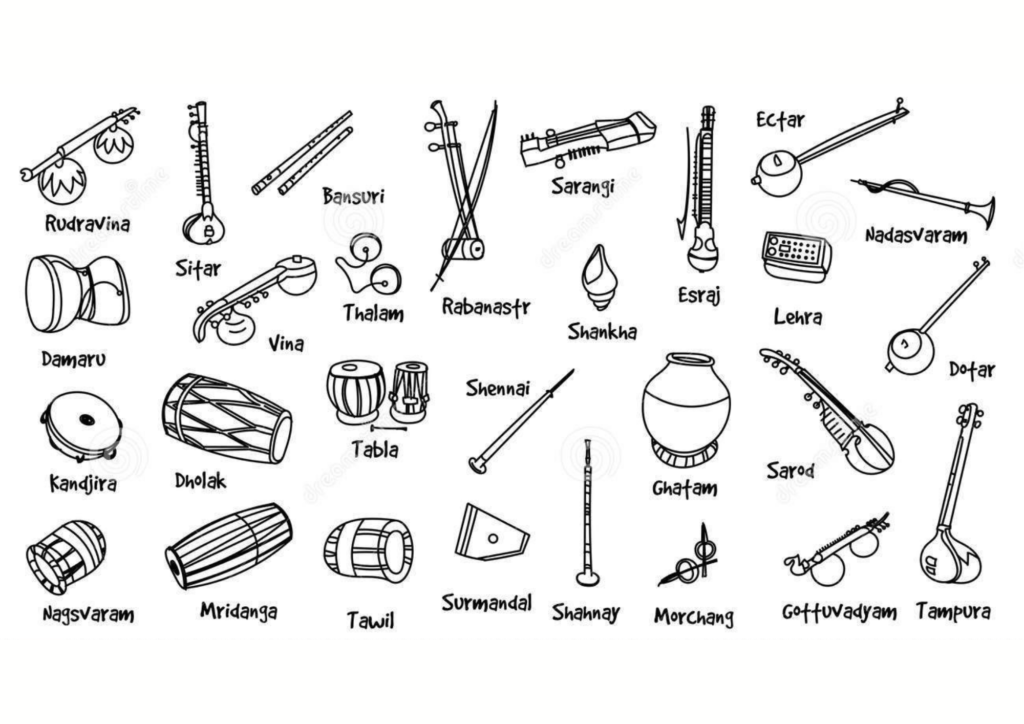
4 Common Hindustani classical music instruments
Sitar – The most popular Hindustani Classical Instrument
Sitar is one of the main Hindustani music instrument and it is made of the plucked instruments. Sitar was invented during the 1800s period; popular in Northern India, Pakistan, and Bangladesh. It looks like a gourd-shaped, long neck and wide, both sides are tuning pegs. Sitar is used at 45-degree angle on the laps of the musicians while seated. In this Hindustani music instrument, the strings are metal; each one of them is plucked through the right forefinger, while the left-hand touches the strings with a soft pressure amidst the frets.
The name sitar derived from the Persian word ‘Sehtar’, it means “three-strings”. Pandit Ravi Shankar, Pandit Nilkil Banerjee, Annapurna Devi; they all are veteran Sitar players in India.
To learn all about Sitar, Please go through this lesson on Sitar – the classical music instrument.
Sarod – First rate Hindustani Classical Instrument
Sarod is another very popular Hindustani music instrument. The Sarod arrived in India during the 16th century and the modern form was designed in the 19th century. This is one of the first-rate instruments in the Northern part of India. It has four to six melodic wires, along with two or four others; some of them are paired in double courses tuned at Octave. This Hindustani instrument is made of wood and the shape is quite similar to the instrument sitar; although, Sarod has no frets; triangle-shaped plectrum is used to pluck the wires.
Some veteran Sarod maestros are Ustan Amjad Ali Khan from Bangladesh, Pandit Buddhadev Dasgupta, Zarin Daruwalla, and many more.
Sarangi – The Bowed Hindustani Classical Instrument
Sarangi Hindustani instrument is also known as Saranga. It is a bowed, short-necked string instrument. It is popular in the Hindustani classic music world and the folk music world as well. Most renowned Sarangi players in India- Ustad Faiyaz Khan, Dhruba Ghosh, Sabri Khan, Ustad Sultan Khan and many more.
Bansuri – Woodwind Hindustani Classical Instrument
Bansuri is a woodwind Hindustani classical instrument; originating from the Indian subcontinent. This instrument appears in the Hindustani classical music; also called as Baashi, Murali, Bansi, and Baanhi. It is a side-blown flute, produced from bamboo. Ravi Shankar Mishra is the finest Bansuri maker in the Hindustani music genre.
Bansuri is a cultural and religious significance among Hindus. Bansuri artists in India – Hariprasad Chaurasia, Ronu Majumdar, Pandit Raghunath Seth.
Shehnai, Tabla, Pakhawaj such instruments are also famous in the Hindustani classical music.
4 Types of Indian Classical Music Instruments
Rishi Bharat classified Indian classical music instruments into four types–
- Tantu Vadya (Indian String Instruments)
- Sushir Vadya (Indian Wind Instruments)
- Avanadh Vadya (Indian Percussion Instruments)
- Ghana Vadya
Tantu Vadya (Indian String Instruments)
It is the category of string instruments. In the western music world, they are called Chordophones. Such Indian String instruments are:
Drone instrument – Tanpura
It is a drone instrument in Indian classical music; cannot be played in solo performances as it is an accompanying instrument.
Tat Vadya or Nakhaj Vadya
In this category, instruments are played by using nails. Such instruments are- Veena, Sitar, and Sarod.
Vitat Vadya
Such instruments are played with a bow. These are Sarangi and Violin.
Santoor is also a string instrument. It is played by a spoon-shaped hammer, not by a bow.
Sushir Vadya (Indian Wind Instruments)
Western music named it as Aerophones. Such instruments are
- Shankh
- Bansuri
- Shehnai
- Harmonium.
Avanadh Vadya or Charmaj Vadya
Western music called it as Membrophone or Drums Instruments. It contains a layer of animal skin, and such instruments are-
- Mridangam
- Khanjira
- Pakhawaj
- Tabla
- Chaughada
- Dhol.
Ghana Vadya or Idiophone
These instruments are made of metal, clay or wood. These are are-
- Ghatam
- Morsing
- Manjira
- Kartaal.
Synthesizer, Electronic-Tabla, Electronic-Tanpura they all are included in the category of Electronic instruments.
4 Common Carnatic classical music instruments
Mridangam
Mridangam is a percussion instrument and also a rhythmic accompaniment in the Carnatic classical music. It is a two-headed drum; made of wood. The left side is tuned an octave lower than the right side. Mridangam is similar to the Hindustani instrument Pakhawaj; it also used throughout Pakistan and Bangladesh as well.
Khanjira
Khanjira is a rhythmic accompaniment, popular in South India, invented by Manpoondia Pillai. This instrument is made of wood of the jackfruit tree and also made from the dried gourd or lauki.
Ghatam
This instrument is very popular in the Carnatic music world; as it is an ancient percussion instrument. The word Ghatam derived from the Sanskrit word ‘Ghata’; it is large, narrow-mouthed earthenware pot instrument; ancient poet Sage Valmiki first described this pot as an instrument in the poem Ramayana during 500 CE.
Tanpura
Tanpura or Tanbura is a drone instrument; popular in both sides of the Indian musical world. In Hindustani music, it is famous as Tanpura, whereas in Carnatic music it is called as Tanbura. This instrument has four strings, a long neck, made of Ivory or Wood and originating from India itself.
Nellai Krishnan, Indira Sheshadri, Gowrishankar Guruswamy, Jayank Naidu, Prakash Naik and many other Tanpura or Tanbura players marked their name in the Indian musical world.
Not only Tanpura or Tanbura but also Harmonium, Veena, Violin, Santoor are the instruments that are available in both parts of India.
Share with your friends


